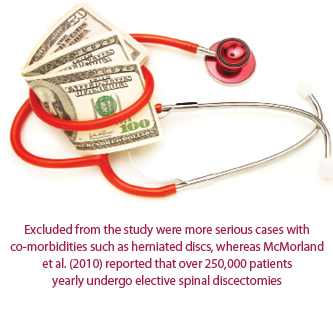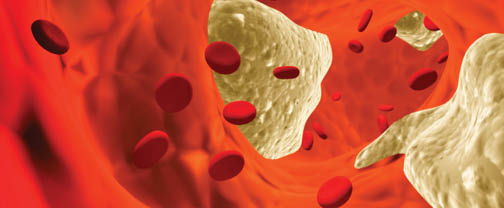:dropcap_open:T:dropcap_close:he parameters for the utilization and timing of chiropractic care are seemingly misappropriated in mandated guidelines at the expense of the general public and public and private insurers who end up spending more at the end of the day based upon current literature. These incorrectly mandated utilization guidelines increase recurrence and ensuing disability of the injured while not taking into account complex diagnosis. A 2010 study by Becker et al. reported the incidence of low back pain (LBP) in the United States at 22.5% of the population. On September 11, 2011, according to the US Census Bureau, the population of the United States was exactly 312,227,241. If you factor in the 22.5% of patients that experience low back pain, that equates to 70,251,129 people yearly having low back pain. According to Dagenais et al. (2008), “The largest proportion of direct medical costs for LBP was spent on physical therapy (17%) and inpatient services (17%), followed by pharmacy (13%) and primary care (13%). Among studies providing estimates of total costs, indirect costs resulting from lost work productivity represented a majority of overall costs associated with LBP” (p. 8).
 Wasiak et al. (2007) reported in the Journal of Occupational Medicine in a study sponsored by the Liberty Mutual Research Institute for Safety that their findings did not support a benefit of longer chiropractic care in preventing work-disability in occupational low back pain. A limitation in that study was that it did not actively seek non-complicated, non-severe occupational low back pain in an attempt to homogenize the results. Excluded from the study were more serious cases with co-morbidities such as herniated discs, whereas McMorland et al. (2010) reported that over 250,000 patients yearly undergo elective spinal discectomies, many as sequellae from occupational injuries. The study reported that “Both the surgical and chiropractic groups reported no new neurological problems and had only minor post-treatment soreness. 60% of the patients who underwent chiropractic care reported a successful outcome while 40% required surgery and of those 40%, all reported successful outcomes. This study concluded that 60% of the potential surgical candidates had positive outcomes utilizing chiropractic as the alternative to surgery” (McMorland et al., 2010, p. 582).
Wasiak et al. (2007) reported in the Journal of Occupational Medicine in a study sponsored by the Liberty Mutual Research Institute for Safety that their findings did not support a benefit of longer chiropractic care in preventing work-disability in occupational low back pain. A limitation in that study was that it did not actively seek non-complicated, non-severe occupational low back pain in an attempt to homogenize the results. Excluded from the study were more serious cases with co-morbidities such as herniated discs, whereas McMorland et al. (2010) reported that over 250,000 patients yearly undergo elective spinal discectomies, many as sequellae from occupational injuries. The study reported that “Both the surgical and chiropractic groups reported no new neurological problems and had only minor post-treatment soreness. 60% of the patients who underwent chiropractic care reported a successful outcome while 40% required surgery and of those 40%, all reported successful outcomes. This study concluded that 60% of the potential surgical candidates had positive outcomes utilizing chiropractic as the alternative to surgery” (McMorland et al., 2010, p. 582).
A study by Legorreta (2004) compared more than 1.7 million insured patients looking for treatment for back pain. The outcomes showed when chiropractic care was pursued the cost of treatment was reduced by 28%, hospitalizations were reduced by 41%, back surgery was reduced by 32%, and the cost of medical imaging, including x-rays and MRIs, was reduced by 37%! Furthermore, 95% of the patients that received chiropractic care said they were satisfied with their treatment. Utilizing chiropractic care as the first treatment option for back pain was estimated to have the potential to reduce US healthcare costs by more than $28 billion annually.
It is these types of conditions that are excluded from the Journal of Occupational Medicine and Liberty Mutual’s study that render a full perspective on the benefits of chiropractic care both as a first line treatment modality and as an option for the care of more serious conditions other than non-complicated low back pain. Municipalities such as the New York State Workers’ Compensation Department have adopted treatment guidelines based upon the work and conclusions of the American Academy of Occupational Medicine, whom they hired to create treatment guidelines with the ultimate goal of limiting care.
Cifuentes et al. (2011) reported the following in Journal of Occupational and Environmental Medicine in another study sponsored by the Liberty Mutual Research Institute for Safety: “In work-related nonspecific low back pain, the use of health maintenance care provided by physical therapists or physician services was associated with a higher disability recurrence than in chiropractic services or no treatment.” Cifuentes et al. went on to report, “In general…those cases treated by chiropractors consistently tended to have a lower proportion in each of the categories for severity proxy compared to the other groups; fewer used opiates and had surgery. In addition, people who were mostly treated by chiropractors had, on average, less expensive medical services and shorter initial periods of disability than cases treated by other providers” (p. 399).
:quoteright_open:Convicted felons have more rights than New York has given its injured workers.:quoteright_close:
The caveat for other municipalities who are looking at the New York State Workers’ Compensation system as a model is that the 2007 study, which appears to be the governing principle for the acute care guidelines created (no references were made available to the profession), has no regulatory mechanism put in place to alter those now outdated policies without enacting new legislation. Every day that those antiquated guidelines stay in place, the State of New York is losing money by forcing its injured to seek alternative care that has proven more expensive, more invasive and less effective through opiates or surgery. New York has placed a “variance” mechanism for additional care that is under the control of the myopic carriers who, over the last 18 months, have followed their historic pattern of deny, delay and defend, once again forcing the patient into more expensive and invasive care. New York has also removed the civil liberties from the patient by not allowing him/her to “opt-out” of the workers’ compensation system and pay cash; it is impermissible. Convicted felons have more rights than New York has given its injured workers. 
The 2011 Journal of Occupational and Environmental study was conclusive, showing chiropractic to be far superior in treating chronic care patients. However, that has been ignored by New York State, forcing patients to more expensive, far less effective conservative care, addictive opiates and surgery. The system created to save the State of New York money is now primed to cost New York more money because 1) no mechanism was put in place to consider the long-term needs of the injured or allow changes without acts of legislation or swift regulatory changes as evidenced by the above study being published 4 months AFTER the 2001 implementation date, 2) The American College of Occupational and Environmental Medicine specialists brought in to create the guidelines implemented in 2010 did not consider the complete set of independent studies proving chiropractic more effective and less costly and 3) The chiropractic profession was not part of the guidelines committee comprised to help craft guidelines that were usual and customary for chiropractic care, leaving utilization guidelines to actuaries and physicians with no chiropractic experience.
Based upon the global utilization statistics and research findings, chiropractic care is grossly underutilized, effectively increasing both the direct cost of health care for low back pain in both non-complicated and complicated cases. In addition, the resultant indirect costs including, but not limited to, disability benefits and increased work absenteeism effectively lower both the tax base and productivity.
by Mark Studin, D.C., FASBE(C), DAAPM, DAAMLP and William J. Owens, D.C., DAAMLP
References:
- Becker A, Held H, Redaelli M, Strauch K, Chenot JF, Leonhardt C,…Donner-Banzhoff N. Low back pain in primary care: Costs of care and prediction of future health care utilization. Spine J. 2010 Aug 15;35(18):1714-20.
- Census.gov. (2011, September 11) U.S. & World Population Clocks. U.S. Census Bureau, Retrieved from http://www.census.gov/main/www/popclock.html
- Dagenais S, Caro J, Haldeman S. A systematic review of low back pain cost of illness studies in the United States and internationally. Spine J. 2008 Jan-Feb;8(1):8-20.
- Wasiak R, Kim J, Pransky G. The association between timing and duration of chiropractic care in work-related low back pain and work-disability outcomes. J Occup Environ Med. 2007 Oct;49(10):1124-34.
- McMorland G, Suter E, Casha S, du Plessis SJ, Hurlbert RJ. Manipulation or microdiskectomy for sciatica? A prospective randomized clinical study. J Manipulative Physiol Ther. 2010 Oct;33(8):576-84.
- Legorreta AP. Comparative analysis of individuals with and without chiropractic coverage. Arch Intern Med. 2004 Oct 11;164(18):1985-92.
- Cifuentes M, Willets J,Wasiak R. Health maintenance care in work-related low back pain and its association with disability recurrence. J Occup Environ Med. 2011 Apr;53(4):396-404.
Dr. Owens has established the nation’s first chiropractic elective in a Family Residency Program with the SUNY at Buffalo School of Medicine and Biomedical Sciences. He has developed and credentials chiropractors to teach courses approved for CME credit to the medical community. He can be reached at 716-228-3847.


